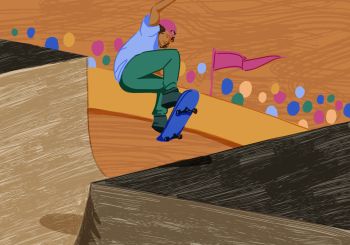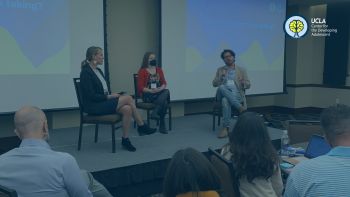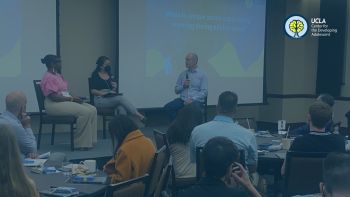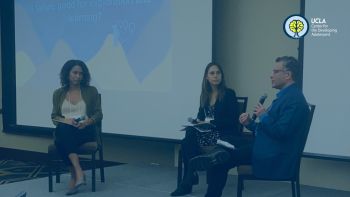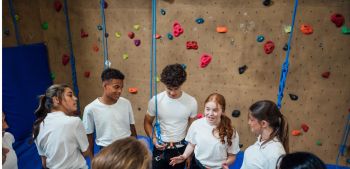Exploration & Risk Taking

5 Facts About Exploration and Risk Taking During Adolescence
Being able and willing to take risks and try new things is a part of our natural tendency to explore the world during adolescence. It’s a fundamental aspect of learning that helps us expand our skills, discover who we are, and ultimately leave the familiarity of home.
The willingness to approach the new and unknown during adolescence is an important quality that helps us adapt to the world and prepare for adulthood. But long-standing racial and economic inequities in our society often limit opportunities to take healthy risks and amplify negative consequences from mistakes for youth from traditionally marginalized groups.
Adults need to support policies and programs that provide opportunities for healthy exploration and positive risk taking for all adolescents.
What research says about exploration and risk taking during adolescence:
- Our brains undergo significant changes during adolescence that increase our sensitivity to positive feelings that come from new experiences. These positive feelings are amplified when we’re with our peers.
- This increased motivation to explore and take risks is fundamental to learning the skills and knowledge we need to thrive as adults.
- Learning a new skill, trying out for a team, asking someone out, standing up for a cause that we believe in, or sticking up for someone else are all forms of positive risk taking.
- Adults can support healthy outcomes for youth and their communities by ensuring that opportunities to explore, take positive risks, and learn from mistakes are available equally to all young people.
Research has shown that during adolescence, we are more willing than adults to lean into uncertainty and explore situations in which our desired outcome is not assured.
This tolerance for uncertain outcomes is essential to learning and development during adolescence. Attempting to learn a new skill, trying out for a team, asking someone out, and standing up for a cause all feel very risky—especially during adolescence, when most of us are trying these things in new ways or for the first time. Fortunately, aspects of development during these years motivate us to face these risks and expand our world.
Our brains undergo significant changes during adolescence—one area of change involves the dopamine system. Dopamine is a neurotransmitter important for learning and motivation, and is involved in how the brain processes desired outcomes and rewards. It also plays a role in executive functions such as attention and cognitive control that help support decision making.
A surprising or unexpected reward causes an extra dopamine release. Every time we do something with an uncertain outcome—taking a “risk”—dopamine is released, alerting other parts of the brain that the activity or situation is new and deserves attention. This is a kind of amplified learning that’s actively shaping the connections between neural systems in our brains.
During adolescence, our brains release more dopamine compared to children or adults, increasing our sensitivity to the rewards and good feelings that come from surprises and new experiences. This response becomes amplified when peers are present (or if we even think our peers are watching), making rewarding feelings from both healthy and unhealthy risks more intense when we’re with our friends. This heightened sensitivity in the context of peers can also encourage learning and exploration by motivating us to take positive risks and engage in prosocial behavior. Participating in activism, standing up for causes that we believe in, or sticking up for someone else all happen in peer contexts.
Although not all adolescents are comfortable with risks, our reward system during these years is generally more excited by risks than at other times in our lives. Without healthy outlets, the attraction of risk and novelty can make us more vulnerable to unhealthy behaviors, such as reckless driving or excessive drug and alcohol use. We need avenues to channel this motivation for new experiences into positive exploration.
Unfortunately, such opportunities for healthy risk taking are not equally available to all of us during adolescence. A history of racial and economic inequities have led to fewer resources for organized activities in schools and neighborhoods with higher populations of youth of color. Racism and bias, such as Black and other ethnic minority youth sometimes being perceived as more adult-like than their same-aged White peers, often results in more extreme consequences (such as suspension, expulsion, arrest, or incarceration) for mistakes that might be labeled “learning experiences” when made by White adolescents.
Our increased motivation to explore and take risks when we’re adolescents is fundamental to learning during this important window of development. Adults can support positive trajectories for youth and their communities by ensuring that opportunities to explore, take positive risks, and learn from mistakes are available to all young people.
What the research says about programs to support our need to take positive risks during adolescence:
- Taking academic risks, like signing up for an advanced class or taking on other academic challenges can be a way to build resilience in school.
- Running for a leadership position or starting a volunteer program are positive activities that may feel risky, but are related to positive youth development by fostering a sense of purpose and overall life satisfaction.
- Youth activism programs can promote social skills and global awareness.
- Adventure-recreation programs for adolescents featuring activities like whitewater rafting, backpacking, and rock climbing have been shown to increase self-efficacy and a stronger sense of identity, and may offer a positive outlet for age-related sensation seeking.
We need opportunities during adolescence to try new things and learn from whatever the outcome is. Outlets for healthy risk-taking can help support our developmental need to explore during these years and may also help redirect our desire for new experiences toward positive activities such as trying a new sport, engaging in activism, or making new friends.
Despite an abundance of research on risk taking, few studies have explored the role of positive risk taking during adolescence. Programs that target risk behaviors during adolescence have generally focused on reducing negative risk taking, rather than promoting positive risk taking. Below we outline what the research does tell us about how schools and communities can provide opportunities for youth to take healthy risks.
Learning and Education
Taking risks can be a valuable tool for learning. Signing up for an advanced class or taking on other academic challenges can be a way to build resilience in school. But students don’t always feel they can take academic risks when failure can have consequences for their grades and future success in school. Education researchers are increasingly emphasizing the importance of taking risks in academics, with some evidence that youth who are willing to take on more challenging coursework without knowing how they’ll do are more goal-oriented and have more positive attitudes about science. Opportunities to take academic risks should be incorporated across subjects as a way for youth to learn how to persevere through challenges and expand their skills.
Outside the classroom, extracurricular activities can be another avenue for positive risk-taking. Running for a leadership position or starting a volunteer program are positive activities that may not succeed, but research consistently suggests that participation in these activities is related to positive youth development such as feeling a sense of purpose or overall life satisfaction.
Engagement in civic activism in particular can involve some amount of risk for adolescents, particularly for those advocating for racial justice. But research suggests that youth activism programs can promote social skills and global awareness. Evidence also suggests that while negative risk taking is related to less school engagement, positive risk is related to greater school engagement. Together these findings suggest that school-based interventions seeking to improve students’ academic success or engagement at school could benefit from incorporating elements of healthy risk taking into their programs.
Health and Wellbeing
Sports and recreation programs can also provide opportunities for youth to build developmental skills while taking positive risks. For example, the Dirt Divas program is a mountain biking day camp for 10- to 16-year-old girls. Youth in the program engage in positive risk taking while mountain biking and in the process build resiliency and boost self-esteem.
Other adventure-recreation programs for adolescents featuring activities like whitewater rafting, backpacking, and rock climbing have found similar benefits for youth, including increased self-efficacy and feeling a stronger sense of identity. Research suggests that adolescents’ tendencies for both positive and negative risk taking may be related to heightened sensation seeking–that is, the increased motivation toward novel, exciting experiences. If sensation seeking makes young people more inclined to take risks, then these programs may be a way for young people to channel that inclination into healthy activities that support positive development.
Future Directions
Taking risks is critical to learning and a normal part of healthy adolescent development. Positive risk taking is an understudied area of research, and few youth-serving programs directly promote or evaluate it. School-based interventions can be a way to explore the potential benefits of risk taking for academic success and engagement, while sports and recreation programs may provide youth with healthy alternatives to more negative kinds of risks. Future research can help us understand the best ways to harness young people’s desire to explore and take risks to promote positive development.
Additional Resources
Resources | June 2, 2022
2022 Adolescent Brain Development Symposium: Supporting Exploratory Learning During AdolescenceResources | December 20, 2019
The Science Behind Adolescent Risk Taking and ExplorationNews | April 17, 2019
Adolescents Are More Likely to Take Risks, and That’s a Good ThingNews | February 6, 2018
Teens aren’t just risk machines – there’s a method to their madness
